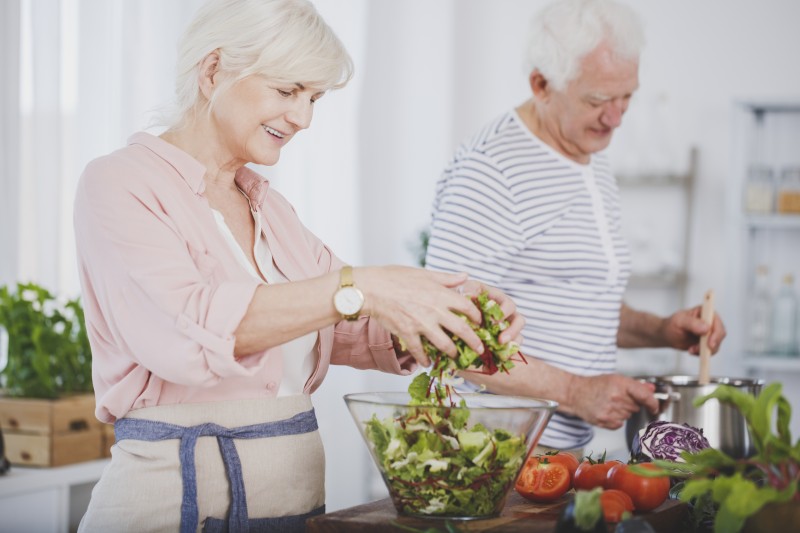The statistics are alarming: One in three people age 65 and older have either type 1 or type 2 diabetes, and the disease affects nearly 12% of the total U.S. population. In addition, nearly half of older adults have prediabetes, a condition that features higher-than-normal blood glucose levels. Prediabetes can lead to type 2 diabetes unless a lifestyle and diet change is adopted to slow the onset or prevent the disease entirely.
Even more frightening — most people, especially seniors, are unaware they have the disease until its effects become more serious.
Many factors associated with aging, such as depression, cognitive challenges, financial difficulties, multiple illnesses, and the loss of a spouse, can undermine a senior adult’s ability and willingness to deal with his or her diabetes.
If unchecked, diabetes has a host of serious complications including:
- Increased risk for infections and injuries
- Accelerated muscle loss
- Damaged kidneys
- Increased risk for Alzheimer’s disease
- Increased risk for heart attack or stroke
- Vision loss
- Persistent pain
- Nerve damage
- Limb amputation
Diet is also key to controlling diabetes but, as an added challenge, many older adults suffer from a loss of appetite as their ability to taste and smell diminishes. In addition, their energy and activity levels drop, and depression may become a factor.
Tips for Managing Diabetes in Seniors
-
Controlling Carbohydrates
A person with type 1 diabetes cannot produce insulin (also called insulin-dependent diabetes). It’s very important for people with type 1 diabetes to coordinate the amount of carbohydrates they consume in conjunction with their insulin injections. With type 2 diabetes, the body produces insulin, but the cells resist taking it in. Type 2 diabetes often requires just a diet and lifestyle change, including exercise and weight loss. Other cases may require oral medications or insulin, and sometimes all of these in combination must be put into practice to address the disease.
Carbohydrate control is key to managing both types of diabetes, as the body turns carbohydrates into glucose, making blood sugar levels rise.
Eating a diet lower in carbohydrates featuring lean protein (beans, poultry, fish), and whole grain foods slow the release of sugar into the bloodstream. However, seniors should still consume at least 135 grams of carbohydrates per day, depending on their size and activity levels (consult with a physician or registered dietician to find the recommended amount for you.) Most people trying to lose weight feel best eating 45g of carbohydrates at each meal, three meals per day. If they are more active, often a daily snack around 3 p.m. with 15-20g of carbohydrates (for example: low-fat fruit yogurt with ¼ cup almonds) will keep the metabolism fueled and prevent excessive snacking later in the day.
-
Understanding Fats
When making efforts toward managing diabetes in seniors, some people mistakenly try to completely eliminate fat from their diet. However, some fats are necessary for good health, like those found in avocados, nuts, and olives. Trans fats and saturated fats are the ones we should try to consume less of.
A diet filled with fat-free items can lead to low blood sugar (called hypoglycemia) or feeling hungry between meals. In addition, if the label says ‘fat-free,’ often sugar, salt and/or artificial sweeteners have been added.
-
What Not to Consume
Sugary drinks, juice, sweet tea, lemonade, and excessive amounts of milk are high on the list of what not to consume. It is also recommended to eliminate or reduce alcohol consumption, limit salt intake, avoid packaged or processed food, and reduce cholesterol intake to 200mg per day. As previously stated, your physician or a registered dietitian can help you determine the best diet guidelines for your current body and health status.
-
The Good Stuff
The key to managing diabetes in seniors is making sure you fill your plate with more nutritious foods. Try these:
- Lean protein: low-fat dairy, skinless fish and poultry (or a smaller portion with skin of 3-4 oz.), and leaner cuts of beef.
- Good carbohydrates: whole-grain foods, legumes such as lentils, peas, beans, and sweet potatoes.
- Fiber: fruits, legumes, oatmeal, vegetables, and whole grains.
- Good fats: avocados, nuts/nut butters, olives, butter, and canola oil (good for higher heat cooking).
- Fruits and vegetables: For vegetables, think green: broccoli, spinach, asparagus, Brussels sprouts, and leafy greens. For fruits, think the colors of the rainbow: tomatoes, grapes, apples, oranges, and cherries.
-
Manage Diabetes in Seniors by Educating Yourself
If you suspect that you might have diabetes, get tested. According to the American Diabetes Association, symptoms include:
- Frequent urination
- Feeling very thirsty
- Feeling hungry — even though you have eaten
- Extreme fatigue
- Blurry vision
- Cuts/bruises that are slow to heal
- Tingling, pain, or numbness in the hands/feet
Diabetes control is a balancing act that requires education. For example, those who have diabetes should be aware of the symptoms of hypoglycemia. They include sweating, fatigue, dizziness, paleness, or blurred vision, and can result in loss of consciousness or coma. Glucose tablets or snacks should be consumed, and glucose levels should be monitored every 15 minutes until they return to normal.
People with diabetes should also know how to use a glucometer and what an A1C test reveals about how well they have managed their diabetes over a period of months.
If you are struggling with managing diabetes, ask your primary care physician for a referral to a registered dietitian and/or a certified diabetes educator for help. Diabetes is not a disease that can be ignored or taken lightly.
Find more Senior Health & Wellness tips on our blog!
This blog was originally published on June 15, 2021 and was last updated on January 10, 2025.





